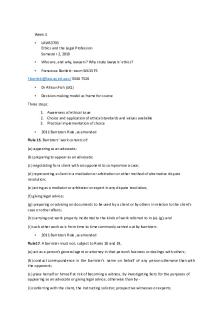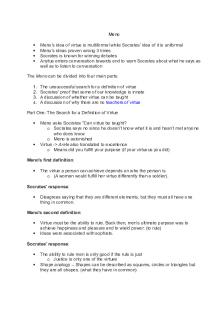Summary of Lecture 5 PDF

| Title | Summary of Lecture 5 |
|---|---|
| Course | Genes And Development |
| Institution | University of Manitoba |
| Pages | 6 |
| File Size | 146.6 KB |
| File Type | |
| Total Downloads | 68 |
| Total Views | 128 |
Summary
Lecture 5(online learning) summary...
Description
Lecture 5: NGS.
Last generation: (1) Maxam-Gilbert Sequencing – degradation method (diff.) (2) Sanger Sequencing a. Radiographs b. Dye-based --------------------------------------------------------------------------------------------------------------------------------1970s. MAXIM GILBERT SEQUENCING: DNA degradation Seq degradation method o 4 rxns (G, C; AG, CT) Covalently modified nt o Radioactive P-32. (P at 5’ end labelled) Cleavage by piperidine. Separate = electrophoresis Read nt up the gel Max read length: 500 bp.
1985. SANGER: DNA synthesis. Replaced M-G DNA synthesis (not DNA degradation) First method: used radioactively labelled nt + ddNTP in 4 rxns o Radioactive P-32. (P at 5’ end labelled) Read: autoradiographs (on X-Ray film) Max read lengths: 200-500 bp routine. Advantage: less radioactive, fewer hazardous chems than M-G.
1990S. SANGER: automated fluorescent dye-labelled Sanger-sequencing. Second method: used dye labelled nt + ddNTP in 1 rxn only.
o Each ddNTP associated w/ 1 colour. Max read lengths: 1200 bp.
Advantage: removed radioactivity element of procedure (safer process) … quicker process + longer read lengths. diff peaks for diff colours --------------------------------------------------------------------------------------------------------------------------------
Sequencing Retrospective: DNA sequencing apparatus
Manual or Auto Read Lengths (/day)
1985 – 1995 Manual P/A gel 1200
1996 Semi Auto P/A gel 2400
1998 – 2004 Automated 1 column 14, 400 (14.4k)
2004 – 2010 Automated 8 column 76, 80 (76.8k)
Manual polyacrylamide gel. Automated = no slab gel, used capillary tube instead. Same electrophoresis technique to separate. More reads, less work = lowered cost In 2015, ~ $1000 to sequence a whole human genome. -------------------------------------------------------------------------------------------------------------------------------NEXT GENERATION SEQUENCING: 1) Pyrosequencing 2) Ion torrent PGM 3) Illumina MiSeq 4) Nanopore Sequencing 5) SOLiD 5500XL Sequencing by Ligation
Read length Tether
Pyro
Ion torrent
Illumina
1000 Wells
400 Wells - pH meter
600 Flow cell
Nanopore
SOLiD
Tech Base Sequencing by Products used
Machine Emulsion based – fluo readings DNA synthesis DNAP (3’ 5’) PPi
Machine Sensor for H+ DNA synthesis DNAP (3’ 5’) H+
Machine Sanger dye-based – glass flow cell DNA synthesis DNAP (3’ 5’) Dye-terminator nt
Hand-held Forms pore
Machine Emulsion based DNA ligation DNA ligase (5’ 3’)
------------------------------------------------------------------------------------------------------------------------------ Sequencing is DNA-synthesis based. All depend on tethering individual DNA mlcs to a solid phase (not in sol’n , like the 2 earlier methods) Shorter read lengths than Sanger … but can sequence millions of diff mlcs simultaneously so u get lots of data. Standard Preparation: (slide 9) Nucleic acid fragments Fragment into a standard size (< 800 bp) Polish ends o Make ends clean o Modify end sequences by adding adaptors. This creates a library of sequences. o Middle is unique o The ends are PREDICTABLE, IDENTIFIABLE, UNIFORM so that we’ve a standardized set of mlcs that can be used in machines. ---------------------------------------------------------------------------------------------------------------------------------------------------------------------------------------PYROSEQUENCING: Emulsion of: o 1 strand of library DNA o 1 bead (has an adaptor) o Enz/nts. Vortex mix to create an emulsion which has one bead and one piece of DNA per droplet. Initiate PCR DNA fragment is fused to the bead (adaptor) Fragment gets copied multiple times – each new copy are tethered to the same bead. Result = bead w many identical copies, fused + bonded to the bead.
Add the emulsion PCR products to surfaces with many wells Beads fall into wells as the sample passes over the surface
Sequencing: Melt DNA so only 1 strand is attached to bead (other = washed away) Add DNAP Wash entire array of wells, 1 nt @ time (first wash away A, C, G, T) As each well is washed & the correct nt is added to be properly incorporated into the new strand, a pyrophosphate mlc is released It can interact w luciferin, which breaks the high nrg bond & releases a photon of light. Detection: Nt incorporation releases a pyrophosphate Luciferin breaks high nrg bond in pyrophosphate … releases photon of light. Every time correct nt is passed over array of wells, pyro-phos released --> luciferin produces a fluo outcome.
Field of the wells – some wells are lit up, others not. o Everywhere N nt is added to growing strand, lights up. Can look sequentially @ each nt that’s added.
Reads of up to: 1000 bp. --------------------------------------------------------------------------------------------------------------------------------------------------------------------------------------ION TORRENT PGM: Also bead-based tethering system, but detects protons instead of pyrophosphate using luciferin.
Tiny pH meter sensor associated with each well in an array that makes up chip sequence. Purpose (sensor): to determine when a nt is added to growing DNA strand. What this tells us: which wells are producing a lot of H+ when a particular nt is added to well.
Reads up to: 400 bp. --------------------------------------------------------------------------------------------------------------------------------------------------------------------------------------ILLUMINA MiSEQ: Most popular – can sequence entire human genome in couple of days for ~ $1000 Tether DNA mlcs to a piece of glass instead of using array of wells. Similar to dye-terminated ddNTP (in Sangar sequencing): wash glass slides w dye terminated ddNTP.
Process: Tether DNA to a particular location on the glass PCR amplify to create daughter DNA next to the original mlc o First strand bends over to the probe/substrate next to it o Daughter strand synthesized o Use RE to dissociate one end of strand o But this strand is inverted Create many such copies on the glass Since you’ve strand + its invert, Sequencing same DNA mlc in 2 diff directions gives additional confidence that u sequenced correctly. -------------------------------------------------------------------------------------------------------------------------------------------------------NANOPORE SEQUENCING DNA dbl helix is melted so One strand goes through membrane pore Other strand retained on other side of membrane. As ssDNA pushed thru pore, an adapter mlc measures size & amt of charge assoc. w/ each nt (along ssDNA strand) How much that adapter mlc is displaced from the pore center is determined by which nt is part of ssDNA @ that location in seq. Adapter displacement either inc or dec. (widens/narrows) pore size , allowing larger or smaller flow of ions on either side of DNA mlc. By det. how many ions can flow thru pore, system can determine which nt was @ that position… and record it.
(!) A protein unzips DNA helix into 2 strands. (@) 2nd protein creates a core in the membrane and holds an adapter mlc. (#) ions flow thru pore, creating current … each base blocks the flow to a different degree, altering current flow. ($) adaptor mlc keeps the bases in place long enough for them to be electronically identified. -------------------------------------------------------------------------------------------------------------------------------------------------------SOLiD: **starts off like Pyro. DNA fragment Bind to bead PCR amplif DNA fragment o Many fragment copies on the 1 bead Prepare emulsion PCR for solid sequencing.
Instead of DNA synth, use a set of primers & add many nt @ once.
Hybridize Ligated Fluorescence measured, dye is cleaved off Free 5’ phosphate for further rxns … keep going until full strand synthesized. Synthesized strand removed
New primer hybridized, offset by 1 base. Ligation pattern repeated.
Primer reset is repeated for five rounds. Provides dual measurement of each base Increases sequencing accuracy by several bases. **scalable! -------------------------------------------------------------------------------------------------------------------------------------------------------...
Similar Free PDFs

Summary of Lecture 5
- 6 Pages

Summary - lecture 5, 9
- 19 Pages

ACS - Summary of lecture
- 8 Pages

Summary of lecture notes
- 4 Pages

Summary 7 of unit 5
- 1 Pages

Summary - lecture 5, 7, 8, 10, 11
- 25 Pages

Meno Summary - Lecture notes 1-5
- 4 Pages

Planning Summary - Lecture notes 1-5
- 67 Pages

Lecture 5 anonymity of witnesses
- 2 Pages
Popular Institutions
- Tinajero National High School - Annex
- Politeknik Caltex Riau
- Yokohama City University
- SGT University
- University of Al-Qadisiyah
- Divine Word College of Vigan
- Techniek College Rotterdam
- Universidade de Santiago
- Universiti Teknologi MARA Cawangan Johor Kampus Pasir Gudang
- Poltekkes Kemenkes Yogyakarta
- Baguio City National High School
- Colegio san marcos
- preparatoria uno
- Centro de Bachillerato Tecnológico Industrial y de Servicios No. 107
- Dalian Maritime University
- Quang Trung Secondary School
- Colegio Tecnológico en Informática
- Corporación Regional de Educación Superior
- Grupo CEDVA
- Dar Al Uloom University
- Centro de Estudios Preuniversitarios de la Universidad Nacional de Ingeniería
- 上智大学
- Aakash International School, Nuna Majara
- San Felipe Neri Catholic School
- Kang Chiao International School - New Taipei City
- Misamis Occidental National High School
- Institución Educativa Escuela Normal Juan Ladrilleros
- Kolehiyo ng Pantukan
- Batanes State College
- Instituto Continental
- Sekolah Menengah Kejuruan Kesehatan Kaltara (Tarakan)
- Colegio de La Inmaculada Concepcion - Cebu






